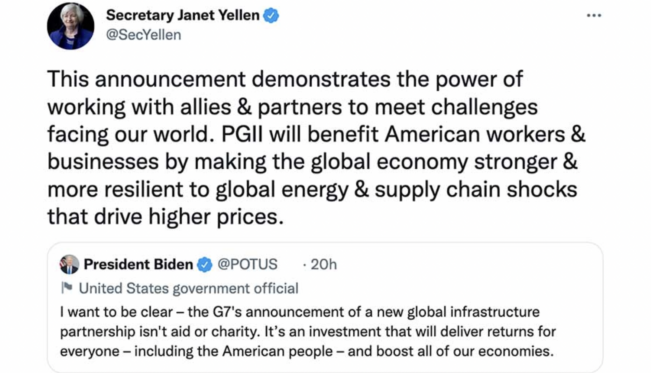[ad_1]
Perhaps predictably, the announcement drew sharp criticism from official Chinese sources. Zhao Lijian, the spokesperson for the Foreign Ministry said: “[W]e oppose the promotion of geopolitical calculations under the banner of infrastructure construction and words and deeds that try to smear and slander the Belt and Road Initiative.”
However, beyond geopolitics, the PGII raises at least four important questions that will need to be answered quickly if this initiative hopes to avoid the same fate as its failed predecessor.
Is PGII designed to combat 2022’s BRI? Oe 2018’s?
The BRI has seen significant changes since its pre-pandemic heyday when multi-billion dollar financing commitments were standard. Since then, Chinese policy banks have sharply reduced financing for hard infrastructure. As part of this trend, the BRI itself was redefined away from physical connectivity, towards boosting digital, health, space and people-to-people connectivity.
The PGII similarly focuses on “climate and energy security, digital connectivity, health and health security, and gender equality and equity.”
Yet its main focus falls on physical infrastructure. With that focus comes the difficulty of securing the money to pay for all that construction. Without the equivalent of state banks, and in a much tighter economy, raising the capital to counter the BRI at anything close to its level will be a significant challenge.
How will everyone work together?
The PGII is a reworking of the Biden administration’s Build Back Better World (B3W) initiative, which emerged in parallel to the EU’s Global Gateway Initiative and the UK’s Clean Green Initiative.
Now that PGII has been relaunched as a G7 project, how it’ll interact with the B3W’s erstwhile siblings remains unclear: “We still don’t know whether [Biden] has integrated the infrastructure investment plans of several countries, or they are just under the same name and making separate independent investments,” commented Guo Hai, a researcher at the Institute of Public Policy at South China University of Technology in Guangzhou.
Additional uncertainty comes from the interactions between the different G7 governments and their respective private and public financing institutions.
For example, the EU is officially supposed to contribute €300bn (about $318bn) of which only €18bn ($19bn) will come from the EU budget.
As Benjamin Fox, a writer for the news site Euractiv commented: “In other words, the Commission is hoping that the European Investment Bank and development finance institutions will generate the bulk of the lending based on a small amount of seed capital.”
Will PGII become tangled in the US government?
President Joe Biden’s official announcement of the PGII revealed that the initiative comes pre-packed with an eye-watering level of government complexity. A sample:
“The Secretary of State, the Secretary of the Treasury, the Secretary of the Interior, the Secretary of Commerce, the Secretary of Labor, the Secretary of Health and Human Services, the Secretary of Transportation, the Secretary of Energy, the Administrator of the United States Agency for International Development (USAID), and the heads of other relevant agencies shall prioritize programming consistent with the policy […] The Chief Executive Officer (CEO) of MCC, the CEO of DFC, the President of EXIM, the Director of the Trade and Development Agency (TDA), and the heads of other relevant independent agencies are encouraged to follow this same line of effort, as appropriate and consistent with their respective authorities.”
At its best, the US government offers an unprecedented set of tools to get things done. However, its many agencies and departments don’t necessarily always pull in the same direction. If the announcement is this complex and acronym-ridden, what will the implementation look like?
How to avoid mission creep (and morality creep)
Like B3W, Global Gateway and many others, PGII is nothing if not full of good intentions. The Biden announcement is jam-packed with inspiring goals. Just providing infrastructure, even if that infrastructure is economically and environmentally sustainable, isn’t enough:
It must also “boost the competitiveness of the United States by supporting businesses, including small- and medium-sized enterprises in overseas infrastructure and technology development, thereby creating jobs and economic growth here at home.”
As well as: “uphold high standards for infrastructure investments and procurement, which safeguard against bribery and other forms of corruption, better address climate risks and risks of environmental degradation, promote skills transfer, generate good jobs, mitigate risks to vulnerable populations, and promote long-term economic and social benefits for economies and communities.”
Oh, and also: “align G7 and other like-minded partners to coordinate our respective approaches, investment criteria, expertise, and resources on infrastructure to advance a common vision and better meet the needs of low- and middle-income countries and regions.”
These are all certainly laudable goals, but how many projects will emerge intact from this gauntlet of norms? It raises one of the oldest reasons African policymakers cite for working with the Chinese: fewer hoops to jump.
If countering the BRI is the PGII’s main goal, it will have to deal with the reality that the stringent and lengthy feasibility procedures implied here are a significant burden to Global South countries, especially the democracies the Biden administration wants to favour. The projects need to be green and sustainable, but Global South policymakers also want them to be delivered before their next election. Will the PGII be able to sufficiently disentangle itself from all its norms to make these projects happen on the ground? We’ll see. Until then, there’s always Chinese infrastructure.
Published in partnership with The China Global South Project
[ad_2]
Source link
